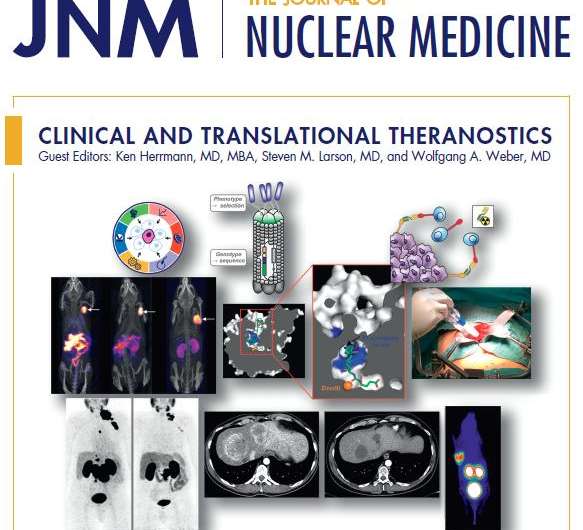Theranostics: Paintball targeting of cancer cells combined with precision therapy

The Journal of Nuclear Medicine's September 2017 supplement shines a spotlight on theranostics and its increasingly important role in the delivery of precision medicine. Theranostics refers to the combination of a predictive biomarker, identified through diagnostic imaging using radiolabeled ligands (which lock onto the specific cancer cell receptor/biomarker), with precise therapy targeted on the now-marked cancer cells. The cancer cells are destroyed, while healthy cells are unharmed—minimizing side effects and improving quality of life for patients.
"Theranostics is the future of precision medicine," explains Wolfgang A. Weber, MD, chief of the Molecular Imaging and Therapy Service at Memorial Sloan Kettering Cancer Center (MSKCC) in New York. "Therapies are not selected based on genetic mutations that may or may not be present in all cancer cells, but on imaging the whole patient and determining if a specific treatment can be effective. Because of the specific targeting of the cancer cells, theranostic agents are extremely well tolerated."
This JNM Supplement on Clinical and Translational Theranostics is edited by Ken Herrmann, MD, MBA, chair of nuclear medicine at the University of Duisburg-Essen, Essen, Germany, and Steven M. Larson, MD, and Weber, both at MSKCC. Their introductory article points out that theranostics is "more than just a fashion trend." It notes that "the idea of using a radioactive compound for diagnostic imaging, target-expression confirmation, and radionuclide therapy dates back to 1946, when Seidlin et al. published the first study on radioiodine therapy for metastatic thyroid cancer. More recently, sodium-iodine-124 and sodium-iodine-131 (Na124I/Na131I) have become important for thyroid cancer monitoring.
Today, Herrmann says, "The theranostic concept has gained new momentum with the recent success of peptide receptor radioligand therapy (PRRT) in neuroendocrine tumors (NETs)." He adds, "The current expansion of this concept to prostate cancer targeting the prostate specific membrane antigen (PSMA) is bringing theranostics to another level. Both are already in clinical use, with PRRT for NETs awaiting FDA approval at any moment."
Articles in the JNM supplement cover research on multireceptor targeting and new strategies for both PSMA imaging/therapy and targeting the somatostatin receptor (so effectively used in PRRT for NETs), as well as exciting research on theranostics for other cancers, including intraarterial yttrium-90 (90Y) therapy for liver metastases. Herrmann points out, "Additional promising theranostic research includes targeting the CXCR4-receptor in hematooncological tumors, the neurotensin 1 receptor in pancreatic cancer, Ewing sarcoma and gastrointestinal tumors, as well as alpha-MSH1 [alpha-melanocyte-stimulating hormone 1] in melanoma."
For nuclear medicine, Weber says, "Theranostics will be practice-changing. Right now, nuclear medicine is dominated by hybrid imaging (PET/CT, SPECT/CT). Theranostics will bring therapy and patient care to the center of nuclear medicine. In other words, the field will change from 'nuclear radiology' to true 'nuclear medicine.'"
Weber emphasizes, "The most important future development is to combine theranostics with other cancer therapies and use theranostics earlier in the course of disease in order to achieve not only prolongation of survival, but cures."
As Herrmann notes, "This is just the beginning of the era of theranostics!"





















